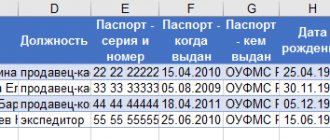March 2020
20 working days and 11 days off
101112131415161718192021222324252627282930311| 2 | 3 | |||||
| 4 | 5 | 6 | 7 | 8 | 9 | 10 |
| 11 | 12 | 13 | 14 | 15 | 16 | 17 |
| 18 | 19 | 20 | 21 | 22 | 23 | 24 |
| 25 | 26 | 27 | 28 |
| 2 | 3 | |||||
| 4 | 5 | 6 | 7 | 8 | 9 | 10 |
| 11 | 12 | 13 | 14 | 15 | 16 | 17 |
| 18 | 19 | 20 | 21 | 22 | 23 | 24 |
| 25 | 26 | 27 | 28 | 29 | 30 | 31 |
;
About working hours in 2020
The production calendar is an important assistant to the employer. The estimated standard working hours of the presented production calendar will help employers determine the number of employees, the duration of working hours during which the employee is required to be at the workplace, draw up work schedules (shifts), avoid errors when calculating wages, and also monitor compliance with duration standards working hours established by the Labor Code.
In accordance with Art. 124 of the Labor Code for each calendar year, the Government or its authorized body establishes the estimated working hours for each calendar year.
Based on sub. 7.1.1 clause 7 of the Regulations on the Ministry of Labor and Social Protection of the Republic of Belarus, approved. By Decree of the Council of Ministers dated October 31, 2001 No. 1589, the estimated standard working time for each calendar year is established by the Ministry of Labor and Social Protection.
For 2020, the estimated standard working time is established by the resolution of the Ministry of Labor and Social Protection dated October 22, 2018 No. 77, according to which, with a full standard working time (40 hours per week), the estimated standard working time for 2020 will be:
– for a 5-day work week with days off on Saturday and Sunday – 2008 hours ;
– for a 6-day work week with a day off on Sunday – 2016 hours.
The calculated standard working time is established based on the full standard working time of 40 hours per week (Article 112 of the Labor Code) for a 5-day work week with days off on Saturday and Sunday and for a 6-day work week with a day off on Sunday.
There are 365 calendar days in 2020. Of this number of days, with a 5-day working week there will be 252 working days, and with a 6-day working week - 304 (12 calendar months are taken into account).
The average monthly number of working days with a 5-day work week will be 21 days (252 / 12), and with a 6-day work week - 25.3 days (304 / 12).
When determining the number of working days, the number of calendar days excludes weekends according to the calendar of a 5-day (Saturday and Sunday) or 6-day (Sunday) working week, as well as public holidays and public holidays, which, according to clause 3 of the Presidential Decree of March 26 .1998 No. 157 “On public holidays, public holidays and memorable dates in the Republic of Belarus” (hereinafter referred to as Decree No. 157) are declared non-working days.
Of the 9 non-working holidays, 8 are celebrated on the days established by Decree No. 157, and the ninth holiday - Radunitsa (according to the calendar of the Orthodox denomination) is celebrated on a certain day depending on the date of the religious holiday "Easter" also according to the calendar of the Orthodox denomination in the corresponding year.
In 2020, non-working holidays will be:
January 1 – New Year;
January 7 – Nativity of Christ (Orthodox Christmas);
March 8 – Women's Day;
May 1 – Labor Day;
May 7 – Radunitsa (according to the calendar of the Orthodox denomination);
May 9 – Victory Day;
July 3 – Independence Day of the Republic of Belarus (Republic Day);
November 7 – October Revolution Day;
December 25 – Nativity of Christ (Catholic Christmas).
Let us note that the religious holiday “Easter”, according to Decree No. 157, both according to the calendar of the Orthodox denomination and the calendar of the Catholic denomination, is not declared a non-working day, and the day of celebration always falls on Sunday. Consequently, for employees whose working hours are determined by the work schedule (shift) and the work time (shift) falls on Sunday (Easter holiday), payment for work on the specified day is made in the usual manner, i.e. like for work on a working day. When hiring workers for whom, according to the established working hours, Easter is a day off, compensation for work on this day is made in accordance with the norms of Art. 69 TK.
For reference: in 2020, Easter holidays are celebrated according to the calendar of the Catholic denomination on April 21, and according to the calendar of the Orthodox denomination - on April 28.
When hiring employees to work on public holidays and public holidays, incl. on public holidays and public holidays coinciding with weekends, payment for work on such days is made at an increased rate, in accordance with the norms of Art. 69 TK. At the same time, if this work was performed in excess of the monthly working time standard, the employee, at his request, may be provided, in addition to the payment provided for in Art. 69 TC, another unpaid day of rest. In this case, for hours of overtime work, 1 unpaid day of rest is provided based on an 8-hour working day (1 day of rest for 8 hours of overtime work).
The published production calendar for 2020 provides the estimated working time for each month of the year with a full working time of 40 hours per week (Article 112 of the Labor Code) and with a reduced working time of 35 hours, 33 hours and 30 hours per week established for individual categories of workers (Articles 113 and 114 of the Labor Code), taking into account days off: on Saturday and Sunday - for a 5-day work week and on Sunday - for a 6-day work week and 38.5 hours, taking into account days off on Saturday and Sunday for a 5-day work week.
Reduced working hours are established for certain categories of workers in connection with age (employee under 18 years old), health status (disabled people of groups 1 and 2), work in harmful and (or) dangerous working conditions based on the results of certification of workplaces for working conditions and some other characteristics of work activity (doctors, teachers, certain categories of employees of cultural organizations). For employees who are not specified in legislative acts, reduced working hours cannot be established.
The duration of work with reduced working hours for each category of workers is determined by law.
For example, Resolution of the Ministry of Labor and Social Protection dated July 7, 2014 No. 57 “On some issues of providing compensation for working conditions in the form of shortened working hours” established a list of industries, workshops, professions and positions with harmful and (or) dangerous working conditions, work in which gives the right to reduced working hours. Resolution of the Ministry of Health dated March 23, 2016 No. 46 “On establishing reduced working hours for medical workers” established a reduced working time for medical workers (with the exception of workers engaged in work with harmful and (or) dangerous working conditions, medical specialists who are heads of healthcare organizations, medical scientific organizations, sanatorium-resort and recreational organizations, other organizations that, along with their main activities, carry out medical activities, separate divisions of these organizations, chief nurses, nutritionist nurses, dental technicians) - 38.5 hours per week.
When determining the estimated standard working time, it was also taken into account that the duration of work on the working day immediately preceding a holiday is reduced by 1 hour.
Both with a 5-day and a 6-day working week, March 7, April 30, May 6, May 8, July 2, November 6, December 24 and December 31 are working days before holidays. According to Art. 116 of the Labor Code, the duration of working hours for employees on the working day immediately preceding a public holiday or a holiday declared non-working by Decree No. 157 is reduced by 1 hour.
In this regard, the estimated working hours for March, April, July and November with a 5-day and 6-day working week are reduced by 1 hour, and in May and December - by 2 hours.
Part-time workers, incl. for those working part-time, the day immediately preceding the holiday is also reduced by 1 hour. This rule can be enshrined in the local regulatory legal act of the organization.
For reference: professional holidays (for example, Economist's Day, Teacher's Day, Lawyer's Day, etc.) are not non-working holidays, and the rule on reducing working hours by 1 hour immediately preceding the holiday does not apply to them.
If, according to production conditions, the reduction in work duration provided for in Part 1 of Art. 116 of the Labor Code, it is impossible, overtime can be compensated with the consent of the employee by providing another unpaid day of rest, as these hours accumulate at the rate of 8-hour working day (1 day of rest for 8 hours of overtime work) or by increasing their payment in the amount established for payment for overtime work in accordance with Part 1 of Art. 69 TK.
Established by Art. 116 of the Labor Code, a reduction by 1 hour in the duration of work on the working day immediately preceding a non-working holiday for employees for whom a summarized recording of working time is established does not mean a corresponding reduction in the norm of working time on this day in the work schedule (shift), since in calculating the norm This reduction in working hours has already been taken into account.
The legislation grants the right to the employer to independently establish the working time schedule (beginning and ending of working hours, breaks, weekends) (Article 123 of the Labor Code) and choose the duration of the accounting period for the summarized accounting of working time (month, quarter, other period) (Article 123 of the Labor Code). 126 TK). The obligatory rule used when drawing up work schedules (shifts) for the summarized recording of working time is the correspondence of the number of hours planned by the schedule for the accounting period to the calculated standard of working time for the same period.
If in an organization, a separate structural unit or for a separate category of employees, days off are constantly provided (every month throughout the year) not on Saturday and Sunday with a 5-day working week and not on Sunday with a 6-day working week, but on other days, for example on Sunday and Monday, then during this operating mode the published production calendar does not apply .
In this case, as well as when establishing a different mode of work in the organization for certain categories of workers, the employer, observing the norms of Art. 112 - 117 The Labor Code is independently obliged to ensure the calculation and establishment of working time standards for these employees of the organization (for a month, quarter, year, accounting period).
It is necessary to take into account that not in all cases the calculated standard working time can be applied to a specific employee who did not work during the calendar year or in certain periods for good reasons (due to temporary disability, labor and other leaves, other cases provided for by law).
In this regard, based on the calculated norm, the employer independently determines the adjusted working time norm for a specific employee.
In this case, the employee may actually work more or less hours of the specified norm for part of the accounting period. For such employees who are dismissed before the end of the accounting period, the date of dismissal with their consent may be indicated:
– taking into account the days allowed for rest in connection with work beyond the established working hours,
– taking into account working days to avoid shortcomings in the estimated working time norm.
It should be noted that when inviting employees to work on weekends and holidays, as well as when postponing working days in the manner determined by resolutions of the Council of Ministers, it is advisable for the employer to provide other days of rest within the current month in order to comply with the monthly calculated working hours.
If the transfer is not carried out within one month, then the order (instruction) of the employer simultaneously determines the estimated standard of working time for each month affected by the transfer.
Planning and recording of working time is carried out by employers in accordance with the Rules for planning and recording of working time of employees in connection with the transfer of individual working days by the Council of Ministers of the Republic of Belarus, approved. Resolution of the Ministry of Labor dated June 25, 2001 No. 75.
For reference: for the purpose of rational use of working time, weekends, public holidays and public holidays, the Government, in agreement with the President, has the right to transfer certain working days to weekends falling on Saturday (Part 6 of Article 136 of the Labor Code). This transfer is carried out by issuing a resolution of the Council of Ministers. As a rule, such resolutions of the Council of Ministers:
– contain specific dates for the republican transfer;
– provide organizations with the right, taking into account the specifics of production (work), to carry out the transfer of working days in a different manner in accordance with the law (both before the postponed working day and later).
It is necessary to take into account that transfers apply only to employees of organizations that have a 5-day working week with days off on Saturday and Sunday, as well as for which the transferred day is a working day, and do not apply to employees of organizations that have a summed up accounting of working hours, as well as those working in a 6-day working week.
If for various reasons (vacation, illness, performance of state or public duties, other cases provided for by law) the postponed working day for a particular employee was not a working day, then such transfer does not apply to him.
When drawing up work schedules (shifts), it should be taken into account that in accordance with Art. 147 of the Labor Code, work is not performed on public holidays and public holidays established and declared by the President as non-working days.
On public holidays and public holidays, work is allowed, the suspension of which is impossible due to production and technological conditions (continuously operating organizations), work caused by the need for continuous service to the population, organizations, as well as urgent repair and loading and unloading work. Moreover, such work is planned in advance in the work schedule (shift) at the expense of the monthly working time standard.
About working hours in the first quarter of 2020
Posted by:
Yuri PEDCHENETS, economist
The article is available for free viewing until:
01.01.2028
June 2020
19 working days and 11 days off
1| 2 | 3 | 4 | 5 | 6 | 7 | |
| 8 | 9 | 10 | 11 | 12 | 13 | 14 |
| 15 | 16 | 17 | 18 | 19 | 20 | 21 |
| 22 | 23 | 24 | 25 | 26 | 27 | 28 |
| 29 | 30 |
| 5 | ||||||
| 6 | 7 | 8 | 9 | 10 | 11 | 12 |
| 13 | 14 | 15 | 16 | 17 | 18 | 19 |
| 20 | 21 | 22 | 23 | 24 | 25 | 26 |
| 27 | 28 | 29 | 30 | 31 |
| 2 | ||||||
| 3 | 4 | 5 | 6 | 7 | 8 | 9 |
| 10 | 11 | 12 | 13 | 14 | 15 | 16 |
| 17 | 18 | 19 | 20 | 21 | 22 | 23 |
| 24 | 25 | 26 | 27 | 28 | 29 | 30 |
September 2020
21 working days and 9 days off
1| 2 | 3 | 4 | 5 | 6 | 7 | |
| 8 | 9 | 10 | 11 | 12 | 13 | 14 |
| 15 | 16 | 17 | 18 | 19 | 20 | 21 |
| 22 | 23 | 24 | 25 | 26 | 27 | 28 |
| 29 | 30 | 31 |
| 2 | 3 | 4 | ||||
| 5 | 6 | 7 | 8 | 9 | 10 | 11 |
| 12 | 13 | 14 | 15 | 16 | 17 | 18 |
| 19 | 20 | 21 | 22 | 23 | 24 | 25 |
| 26 | 27 | 28 | 29 | 30 | 31 |
| 2 | 3 | 4 | 5 | 6 | 7 | 8 |
| 9 | 10 | 11 | 12 | 13 | 14 | 15 |
| 16 | 17 | 18 | 19 | 20 | 21 | 22 |
| 23 | 24 | 25 | 26 | 27 | 28 | 29 |
| 30 |
December 2020
22 working days and 9 days off
1| 2 | 3 | 4 | 5 | 6 | ||
| 7 | 8 | 9 | 10 | 11 | 12 | 13 |
| 14 | 15 | 16 | 17 | 18 | 19 | 20 |
| 21 | 22 | 23 | 24 | 25 | 26 | 27 |
| 28 | 29 | 30 | 31 |
| 2 | 3 | |||||
| 4 | 5 | 6 | 7 | 8 | 9 | 10 |
| 11 | 12 | 13 | 14 | 15 | 16 | 17 |
| 18 | 19 | 20 | 21 | 22 | 23 | 24 |
| 25 | 26 | 27 | 28 | 29 | 30 |
| 2 | 3 | 4 | 5 | 6 | 7 | 8 |
| 9 | 10 | 11 | 12 | 13 | 14 | 15 |
| 16 | 17 | 18 | 19 | 20 | 21 | 22 |
| 23 | 24 | 25 | 26 | 27 | 28 | 29 |
| 30 | 31 |
Standard hours for 2020
Table of standard hours as of 2020, broken down by quarter:
| 1st quarter | 2nd quarter | 3rd quarter | 4th quarter | |
| Total days | 90 | 91 | 92 | 92 |
| Holidays and weekends | 33 | 32 | 26 | 27 |
| Work days | 57 | 59 | 66 | 65 |
| 24 hour week | 271,6 | 280,2 | 316,8 | 311,0 |
| 36 hour week | 408,4 | 421,8 | 475,2 | 467,0 |
| 40 hour week | 454,0 | 469,0 | 528,0 | 519,0 |
Table with summary data for half a year and for the whole of 2020:
| First half of the year | Second semester | In a year | |
| Total days | 181 | 184 | 365 |
| Holidays and weekends | 65 | 53 | 118 |
| Work days | 116 | 131 | 247 |
| 24 hour week | 551,8 | 627,8 | 1179,6 |
| 36 hour week | 830,2 | 942,2 | 1772,4 |
| 40 hour week | 923,0 | 1047,0 | 1970,0 |
Working hours standards for 2020
| Month / Quarter / Year | Amount of days | Working time (hour) | ||||
| Calendar | workers | Weekends | 40 hours/week | 36 hours/week | 24 hours/week | |
| January | 31 | 17 | 14 | 136 | 122,4 | 81,6 |
| February | 28 | 20 | 8 | 159 | 143 | 95 |
| March | 31 | 20 | 11 | 159 | 143 | 95 |
| April | 30 | 22 | 8 | 175 | 157,4 | 104,6 |
| May | 31 | 18 | 13 | 143 | 128,6 | 85,4 |
| June | 30 | 19 | 11 | 151 | 135,8 | 90,2 |
| July | 31 | 23 | 8 | 184 | 165,6 | 110,4 |
| August | 31 | 22 | 9 | 176 | 158,4 | 105,6 |
| September | 30 | 21 | 9 | 168 | 151,2 | 100,8 |
| October | 31 | 23 | 8 | 184 | 165,6 | 110,4 |
| November | 30 | 20 | 10 | 160 | 144 | 96 |
| December | 31 | 22 | 9 | 175 | 157,4 | 104,6 |
| 1st quarter | 90 | 57 | 33 | 454 | 408,4 | 271,6 |
| 2nd quarter | 91 | 59 | 32 | 469 | 421,8 | 280,2 |
| 3rd quarter | 92 | 66 | 26 | 528 | 475,2 | 316,8 |
| 4th quarter | 92 | 65 | 27 | 520 | 468 | 312 |
| 2019 | 365 | 247 | 118 | 1970 | 1772,4 | 1179,6 |
Duration of daily work (shift): - with a 40-hour work week - 8 hours - with a 36-hour work week - 7.2 hours - with a 24-hour work week - 4.8 hours
Holidays in 2020
List of holidays and pre-holidays in 2020:
| Holiday | Pre-holiday day | Holidays |
| New Year holidays | 31th of December | January 1-6 and 8 |
| Nativity | — | Jan. 7 |
| Defender of the Fatherland Day | February 22 | February 23 |
| International Women's Day | March 7 | March 8 |
| Labour Day | April 30 | 1st of May |
| Victory Day | May 8 | 9th May |
| Russia Day | June 11 | 12 June |
| National Unity Day | — | November 4 |
| New Year | 31th of December | — |
The working day before a holiday is reduced by 1 hour. There will be a total of 28 holidays in 2020, which are considered weekends. Pre-holiday days: 7.
Production calendar for 2020 in Ukraine
- Number of calendar days in 2020: 365.
- Including working days: 250.
- Number of weekends and holidays: 115.
- Under the specified conditions, depending on the length of the working week, the standard working time for 2020 will be: for a 40-hour working week - 1993 hours;
- with a 39-hour work week - 1950 hours;
- with a 38.5-hour work week - 1925 hours;
- with a 36-hour work week - 1800 hours;
- with a 33-hour work week - 1650 hours;
- with a 30-hour work week - 1500 hours;
- with a 25-hour work week - 1250 hours;
- with a 24-hour work week - 1200 hours;
- with a 20-hour work week - 1000 hours;
- with an 18-hour work week - 900 hours.
Postponement of holidays in 2020
In some cases, when holidays in 2020 in Russia fall on a day off, the latter is moved to another date.
There will be the usual number of working days in February, since the day off falls on the 23rd (Saturday). This day off is moved to May 10th. There will also be a transfer of holidays in 2019 from January 5 and 6 (Thursday and Friday, respectively) to May 2 and 3. Thus, working days will be reduced in May 2020. There will be 3 fewer of them: May 2-3 and May 10.
No other transfers are planned this year. Thus, all weekends, which will already be such due to holidays, are transferred only to May, making the May holidays (Spring and Labor, as well as Victory) much longer.
Weekends and holidays
The production calendar developed for 2020 includes 104 days when workers will not be able to attend work. Of the total number of days off, holidays make up a small part - only 17 days. These include state and historical dates, as well as professional and Orthodox holidays.
Holiday dates in 2020 will be:
- New Year – 1.01. (Tuesday);
- Nativity of Christ – 7.01. (Monday);
- Defender of the Fatherland Day – 23.02 (Saturday);
- International Women's Day – 8.03. (Friday);
- Spring and Labor Day – 1.05. (Wednesday);
- Victory Day – 9.05. (Thursday);
- Russia Day – 12.06. (Wednesday);
- National Unity Day – 4.11. (Monday).
Due to the holidays in 2020 there will be several periods of long holidays, the longest of which will occur in early January for the Christmas holidays and will be 8 days.
Long weekends are arranged as follows:
- January – period from 1st to 8th (New Year holidays);
- March - from 8 to 10 (International Women's Day, Saturday and Sunday);
- May – (from the 1st to the 5th, as well as from the 9th to the 12th);
- November – from the 2nd to the 4th (Saturday, Sunday and National Unity Day).
Due to the abundance of holidays, there will be only 17 working days in January, and only 18 working days in May, making these months the highest paid.








